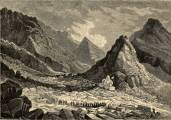


Missouri Geology and Building Stones
Excerpts from
History of Boone County, Missouri...Including a History of Its Townships, Towns and Villages
St. Louis: Western Historical Company, 1882.
(Please note: This book is available for reading or downloading to your computer on Google Book Search.)
Chapter II. - Geology of Missouri
“The stratified rocks of Missouri, as classified and treated by Prof. G. C. Swallow, belong to the following divisions: I. Quaternary; II. Tertiary; III. Cretaceous; IV. Carboniferous; V. Devonian; VI. Silurian; VII. Azoic.
“‘The Quaternary formations, are the most recent, and the most valuable to man: valuable because they can be more readily utilized.
“The Quaternary formation in Missouri, embraces the Alluvium, 30 feet thick; Bottom Prairie, 30 feet thick; Bluff, 200 feet thick; and Drift, 155 feet thick. The latest deposits are those which constitute the Alluvium, and includes the soils, pebbles and sand, clays, vegetable mould, bog, iron ore, marls, etc.
“The Alluvium deposits, cover an area, within the limits of Missouri, of more than four millions acres of land, which are not surpassed for fertility by any region of country on the globe.
“The Bluff Prairie formation is confined to the low lands, which are washed by the two great rivers which course our eastern and western boundaries, and while it is only about half as extensive as the Alluvial, it is equally as rich and productive.’
“‘The Bluff formation, says Prof. Swallow, ‘rests upon the ridges and river bluffs, and descends along their slopes to the lowest valleys, the formation capping all the Bluffs of the Missouri from Fort Union to its mouth, and those of the Mississippi from Dubuque in Jefferson, Washington, St. Francois, Madison, Wayne, Carter, Reynolds, Crawford, Ste. Genevieve, Perry, Cole, Cape Girardeau, Camden, Morgan, and many other counties....’”
“Building Stone and Marble. - There is no scarcity of good building stone in Missouri. Limestone, sandstone and granite exist in all shades of buff, blue, red and brown, and are of great beauty as building material.
“There are many marble beds in the State, some of which furnish very beautiful and excellent marble. It is found in Marion, Cooper, St. Louis, and other counties.
“One of the most desirable of the Missouri marbles is in the 3rd Magnesian limestone, light-drab, slightly tinged with peach blossom, and clouded by deep flesh-colored shades. In ornamental architecture it is rarely surpassed.
“Gypsum and Lime. - Though no extensive beds of gypsum have been discovered in Missouri, there are vast beds of the pure white crystalline variety on the line of the Kansas Pacific Railroad, on Kansas River, and on Gypsum Creek. It exists also in several other localities accessible by both rail and boat.
“All of the limestone formations in the State, from the coal measures to fourth Magnesian, have more or less strata of very nearly pure carbonate of pure lime....”
Commercial use of material within this site is strictly prohibited. It is not to be captured, reworked, and placed inside another web site ©. All rights reserved. Peggy B. and George (Pat) Perazzo.